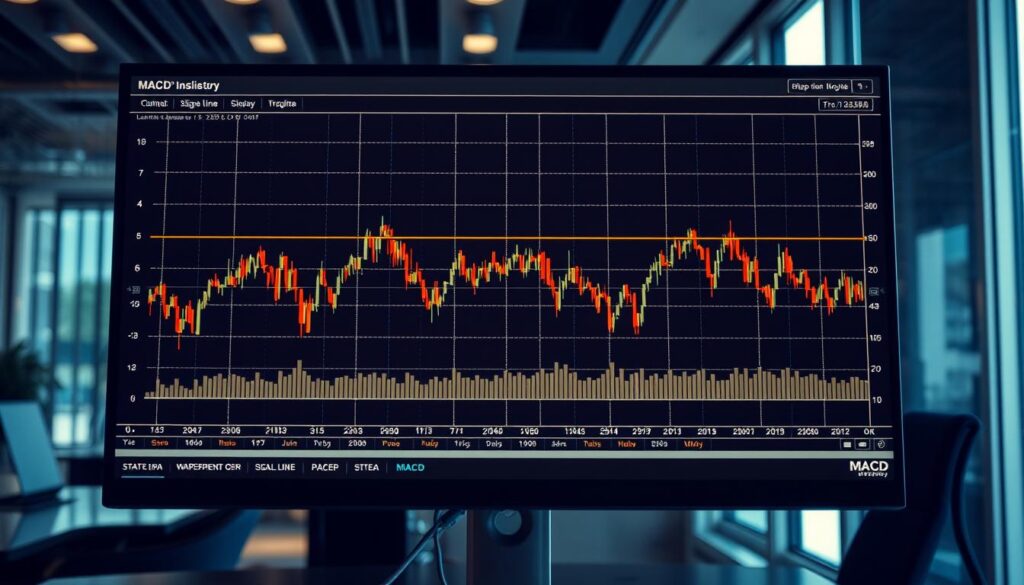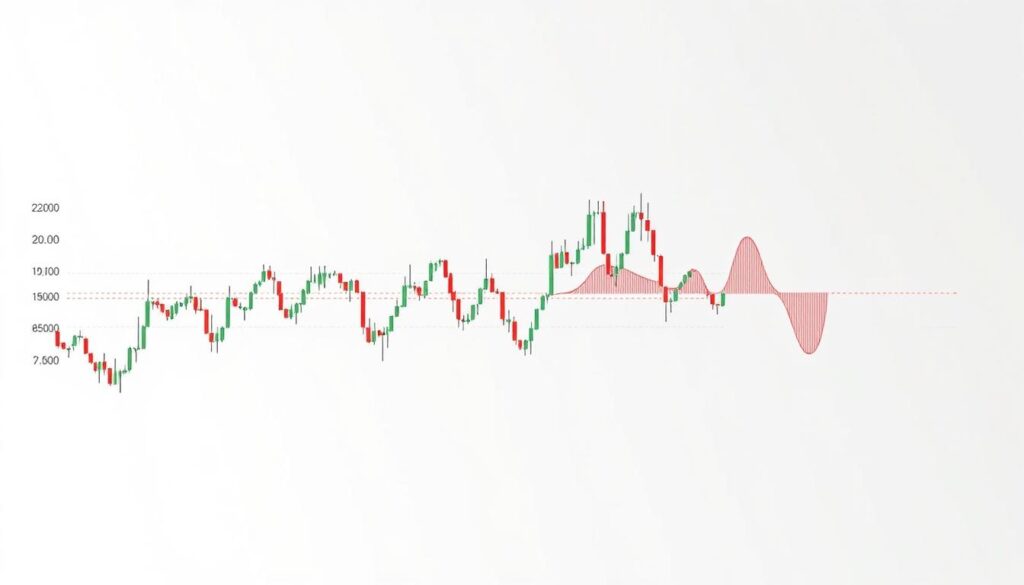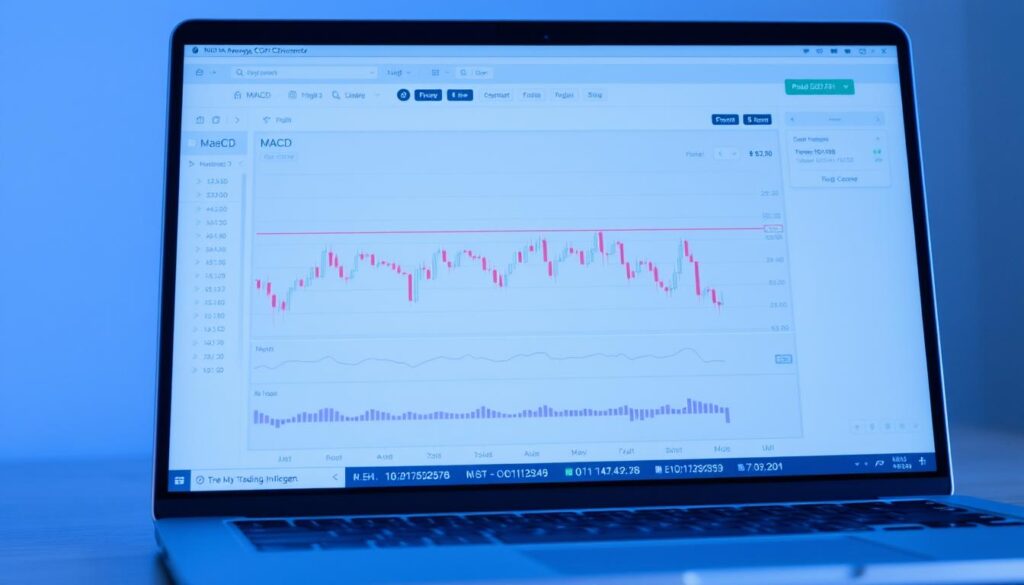Now Reading: MACD Indicator Crypto Trading Guide: Strategies for Success
- 01
MACD Indicator Crypto Trading Guide: Strategies for Success
MACD Indicator Crypto Trading Guide: Strategies for Success

Navigating the fast-paced world of digital assets requires reliable tools. One of the most respected tools for understanding momentum is the Moving Average Convergence Divergence. This powerful method helps traders spot potential shifts in market direction.
Originally developed by Gerald Appel for stocks, this tool has proven incredibly versatile. It now plays a vital role in analyzing various markets, including digital currencies like Bitcoin and Ethereum. Understanding its signals can help you identify potential opportunities.
This resource breaks down the core concepts into simple steps. You will learn how to interpret its components and apply them to your own analysis. We will also explore ways to combine it with other methods for stronger confirmation.
Key Takeaways
- The MACD is a versatile momentum tool effective for analyzing digital currencies.
- It was originally created for stock market analysis but applies well to other assets.
- Understanding its signals can help identify potential buy and sell points.
- Combining it with other analytical methods can improve signal reliability.
- It is useful for various timeframes, from short-term to long-term analysis.
Introduction to MACD and Crypto Trading
Chart analysis has transformed dramatically from its humble beginnings to become a cornerstone of modern market evaluation. What started with hand-drawn lines on paper charts has evolved into sophisticated software. This evolution birthed a wide range of complex analytical tools.
Overview of Technical Analysis
This systematic approach involves studying historical price data and volume patterns. The goal is to forecast future price movements. It provides a framework based purely on market behavior and statistical trends.
This method offers objective, quantifiable signals. It is particularly valuable where traditional valuation metrics are limited. The focus remains on actionable data derived from price action itself.
Relevance in Today’s Crypto Market
The digital asset landscape operates 24/7 with high volatility. Participants face rapid price swings and psychological pressure. Reliable analytical tools are essential for navigating this environment.
The MACD stands out by combining trend identification and momentum measurement. It cuts through market noise to provide clear visual signals. This is crucial for speculative assets that can change dramatically within hours.
As institutional involvement grows, these tools gain further credibility. Professional algorithms often utilize the same methods. This can create effects that enhance signal reliability for all participants.
What is MACD? Definition and Importance
The relationship between two exponential moving averages forms the foundation of this powerful analytical method. This tool helps market participants gauge both direction and strength of price movements.
MACD Definition
Moving Average Convergence Divergence measures the interaction between short-term and long-term exponential moving averages. Gerald Appel developed this approach in the late 1970s for stock analysis.
This method serves a dual purpose. It functions as both a trend-following mechanism and momentum gauge. The visual representation shows when averages are converging or diverging.
The Role of MACD in Trend-Following
Trend identification becomes clearer when using this approach. It helps spot new trends early and confirms existing ones. This prevents entering positions too late or exiting too soon.
Convergence happens when moving averages move closer together. Divergence occurs when they separate. These patterns signal potential trend changes.
Market participants benefit from its ability to filter minor fluctuations. It highlights significant momentum shifts that matter for decision-making. Both retail and institutional investors rely on these signals.
- Reveals relationship between price momentum and trend direction
- Provides early warnings about potential trend changes
- Helps identify overbought or oversold market conditions
- Works across various markets and timeframes
MACD Calculation and Formula Explained
The mathematical engine behind this popular analytical tool is surprisingly straightforward. It revolves around the interaction between two specific exponential moving averages.
This core formula creates the main macd line that practitioners watch closely. It measures the gap between short-term and long-term momentum.
Understanding the 12-26-9 Setup
The standard configuration uses three key numbers. The first two define the primary macd line.
A 12-period exponential moving average reacts quickly to recent price changes. The 26-period ema provides a broader view of the trend. Subtracting the slower average from the faster one gives the tool’s value.
The third number, 9, creates the signal line. This is simply a 9-period ema of the main macd line itself. It helps smooth out the data for clearer alerts.
These settings are highly adaptable. A “period” corresponds to one candlestick on your chart. This means the tool works on hourly, daily, or weekly timeframes.
The histogram offers a visual boost. It plots the difference between the main line and the signal line. This makes spotting changes in momentum incredibly intuitive.
How to Read and Interpret MACD Charts
The ability to read market momentum visually transforms complex data into actionable insights. Graphical displays make trend analysis accessible to practitioners at all experience levels.

Double-tapping the display area expands the view for detailed examination. This reveals the moving averages and histogram components clearly. The blue line typically represents the faster average, while red shows the slower one.
Identifying Crossovers for Buy/Sell Signals
Crossovers serve as primary alerts for momentum shifts. A bullish signal occurs when the main line crosses above the signal line from below. This suggests increasing upward pressure on asset values.
Conversely, a bearish crossover happens when the main line drops below the signal line. This indicates declining momentum and potential selling pressure. These patterns provide clear entry and exit timing.
The Significance of the Histogram
The histogram bars visually represent the distance between the two key lines. Growing bars indicate strengthening momentum in the current direction. Shortening bars signal potential trend weakness.
When bars approach the zero line, a crossover often follows shortly. This gives advanced warning of possible direction changes. The histogram adds depth to simple line analysis.
Standard MACD Settings in Crypto Trading
The power of a widely adopted tool often lies in its consistency. The conventional configuration for this momentum oscillator is the 12-26-9 setup. This has been the industry standard since its creation.
These specific numbers represent periods for exponential moving averages. The 12-period EMA is the fast line. The 26-period EMA is the slow line. The 9-period line acts as the trigger for signals.
A major benefit is the universal application of these parameters. Whether you are looking at Bitcoin on Binance or Ethereum on Kraken, the calculations are identical. This uniformity extends to traditional markets like stocks and commodities.
| Platform/Asset | Fast EMA | Slow EMA | Signal Line |
|---|---|---|---|
| Bitcoin (Any Exchange) | 12 | 26 | 9 |
| Ethereum (Any Exchange) | 12 | 26 | 9 |
| Traditional Stocks | 12 | 26 | 9 |
| Forex Pairs | 12 | 26 | 9 |
This consistency creates a collective effect. When most participants see the same signal simultaneously, it can influence market reactions. This can enhance the reliability of the alerts generated.
While experimentation is possible, beginners should stick with the default values. It is crucial to analyze digital asset charts thoroughly and backtest any custom configurations before committing real capital.
MACD Settings for Crypto Trading: Advanced Adjustments
Moving beyond the standard configuration opens up a world of customization for experienced market participants. Tailoring the parameters allows you to fine-tune the tool’s responsiveness.
This is particularly useful for specific strategies that demand quicker signals. Adjusting the settings can align the analysis with your preferred time frame.

Custom Settings and Their Impact
Professional traders like Linda Raschke have developed notable alternative configurations. Her approach uses a 3-period fast ema and a 10-period slow ema.
The signal smoothing is increased to 16 periods. This combination creates a much faster-reacting tool. It detects potential changes several bars earlier than the standard setup.
The primary advantage is gaining earlier entry and exit points. This speed is ideal for capturing small, rapid price movements.
Insights from Linda Raschke’s Approach
A key innovation in this method is switching from exponential to simple moving averages. This change alters how price data is weighted.
The trade-off for increased speed is a higher chance of false alerts. The tool becomes more sensitive to minor market noise.
Therefore, combining these faster signals with other confirmation techniques is essential. Always backtest any custom settings thoroughly before live use.
MACD indicator crypto trading guide: Strategies for Success
The journey from technical tool recognition to profitable execution involves developing structured approaches. These methodologies combine momentum analysis with disciplined risk management.
Successful approaches recognize that analytical tools work best within comprehensive frameworks. They consider multiple confirmation signals and proper position sizing.
| Strategy Type | Primary Signals | Best Market Conditions | Risk Level |
|---|---|---|---|
| Crossover Approach | Line crossovers, zero-line breaks | Strong trending environments | Medium |
| Divergence Method | Price/indicator disagreement | Trend exhaustion points | High |
| Histogram Technique | Bar expansion/contraction | Established trends | Low-Medium |
Time frame selection significantly impacts strategy effectiveness. Shorter periods generate frequent alerts for active participation.
Longer timeframes produce fewer but potentially more reliable signals. Each approach requires adapting to digital asset characteristics.
Risk management remains inseparable from successful methodologies. Every setup should include predefined exit levels and position sizing.
Strategy validation using historical data helps understand performance metrics. Continuous refinement based on results ensures ongoing improvement.
Using MACD in Conjunction with Other Technical Indicators
Building a robust analytical framework often involves layering multiple technical tools for confirmation. Relying on a single method can lead to false alerts, especially in volatile markets.
Combining different types of tools creates a multi-layered system. This approach filters out noise and increases the probability of successful decisions.

Combining MACD with RSI
The Moving Average Convergence Divergence and the Relative Strength Index are powerful partners. They measure momentum from different angles.
The RSI focuses on the speed and change of price movements. It operates on a scale from 0 to 100. Readings above 70 suggest an asset is overbought, while below 30 indicates oversold conditions.
In contrast, the other tool tracks the relationship between two moving averages. It is unbounded, meaning it has no upper or lower limit. This makes it excellent for showing trend direction and strength.
Their key difference makes them complementary. One identifies potential extremes, while the other confirms the trend’s momentum.
| Feature | MACD | RSI |
|---|---|---|
| Primary Function | Trend & Momentum | Overbought/Oversold |
| Scale Type | Unbounded | Range-bound (0-100) |
| Ideal Signal | Line Crossovers | Crossing 50 or Extreme Levels |
A highly effective strategy waits for confluence. For example, a bullish crossover on one tool is stronger if the RSI is also crossing above 50.
When these tools disagree, it is often best to wait. Mixed signals can indicate choppy, directionless market action. Patience for alignment leads to higher-quality setups.
Crypto Trading Strategies Leveraging MACD
Developing systematic methods for interpreting market signals is crucial for consistent results. These approaches help participants make informed decisions based on momentum analysis.
Two primary techniques form the foundation of effective momentum-based approaches. Each method serves distinct purposes in market analysis.
MACD Histogram and Crossover Techniques
The histogram provides clear visual cues for momentum shifts. When bars cross above the zero line, it suggests buying pressure is increasing.
Conversely, crosses below zero indicate selling momentum. These signals help time entry and exit points effectively.
Historical data shows the reliability of these patterns. Bitcoin’s 50% decline following a bearish cross demonstrates their predictive power.
Divergence Strategies for Reversal Identification
Divergence occurs when price action and momentum readings disagree. This discrepancy often signals potential trend changes.
Bearish divergence appears during higher highs with lower momentum peaks. Bullish divergence shows lower lows with rising momentum.
The MATIC example illustrates this strategy’s effectiveness. Price dropped from $1.60 to $1.30 following clear divergence signals.
Combining both techniques creates a comprehensive approach to market analysis.
Risk Management and Portfolio Considerations with MACD
Protecting capital through disciplined risk protocols is essential when using momentum-based analytical tools. Proper position management often determines long-term success more than entry signal accuracy.
Consistent approaches to stops and profit targets create a framework for sustainable participation. This prevents emotional decisions during volatile market conditions.
Placing Stop Loss and Take Profit Orders
When entering positions based on bearish crossovers, place protective stops above the candlestick where the signal occurred. This approach guards against false alerts while allowing room for development.
A Bitcoin example demonstrated this strategy’s effectiveness. After a sell signal, the asset declined 50% further without triggering the stop loss. This protected profits throughout the downward movement.
For bullish setups, position stops below recent swing lows or the signal candle. The exact placement depends on individual risk tolerance and asset volatility characteristics.
Profit-taking strategies include predetermined targets at key resistance levels. Alternatively, use risk-reward ratios like 2:1 or trailing stops that follow momentum readings.
Avoid waiting for opposite crossovers to exit positions. Since this tool lags price action, significant reversals may occur before confirmation signals appear.
Portfolio considerations emphasize diversification across multiple digital assets. This protects against failed signals on any single position.
Position sizing should correlate with stop-loss distances. Maintain consistent risk exposure across different market conditions. Active participants should exercise particular discipline with quick loss containment.
Successful practitioners maintain detailed journals documenting entry reasons, exit levels, and outcomes. This identifies which setups work best under various market environments.
Applying MACD Across Different Time Frames
The flexibility of this momentum tool across various chart intervals makes it valuable for participants with different schedules and objectives. It works effectively from one-minute views for quick moves to monthly charts for long-term analysis.
For active participants watching markets throughout the day, shorter intervals like 5-minute or 15-minute charts generate frequent signals. These help capture small intraday price movements. Custom settings can increase speed for these compressed time frames.
Swing participants holding positions for days or weeks typically use 4-hour or daily views. Here, signals are less frequent but often more reliable. They align with more significant trend changes that offer larger profit potential.
| Time Frame | Primary Use | Signal Frequency | Ideal Participant |
|---|---|---|---|
| 1-15 minute | Day trading | High | Active monitor |
| 4-hour to daily | Swing positions | Medium | Part-time participant |
| Weekly to monthly | Long-term analysis | Low | Position holder |
Long-term investors use weekly or monthly intervals to identify major market cycles. The same principles apply across all periods. Crossovers show momentum shifts, while histogram expansion indicates strength.
Multi-time frame analysis represents an advanced technique. Checking alignment between daily and 4-hour views ensures consistency. This approach filters noise and improves decision quality.
MACD in Real-World Crypto Trading Platforms
The effectiveness of any analytical method depends heavily on the tools used to implement it. Modern platforms offer professional charting capabilities that bring sophisticated analysis to traders of all experience levels.

Utilizing MACD in the Good Crypto App
Good Crypto serves as a comprehensive mobile terminal for digital asset analysis. The app aggregates accounts from multiple exchanges into one interface.
It provides access to over 20,000 markets across 35 different platforms. Users can apply the momentum oscillator alongside other analytical chart patterns for complete market assessment.
Integrating MACD with TradingView and Other Tools
TradingView represents the industry standard for web-based chart analysis. The platform allows deep customization of all parameters.
To apply Linda Raschke’s settings, traders adjust the fast length to 3 and slow length to 10. Signal smoothing changes to 16, with both moving average types switching from exponential to simple.
This customization enables faster signal generation for active market participants. The platform’s cloud storage preserves personalized setups across devices.
When selecting platforms, prioritize customization options and historical data accessibility. Mobile compatibility ensures you never miss important momentum shifts.
Conclusion
Developing proficiency with analytical tools marks the beginning, not the end, of market education. The principles covered provide a solid foundation for recognizing momentum shifts and potential opportunities.
The versatility of these approaches allows customization for different styles and timeframes. From standard settings to advanced configurations, traders can adapt their strategies to match specific goals.
Effective market participation requires more than just signal recognition. Risk management and disciplined execution ultimately determine long-term success more than any single tool.
Modern platforms have democratized access to professional-grade analysis. This empowers participants at all levels to implement sophisticated strategies.
The journey continues through practice and refinement. Maintain detailed records, review performance regularly, and continuously adapt to evolving market conditions.
FAQ
What is the main purpose of the MACD tool in market analysis?
The primary purpose is to follow momentum and identify potential shifts in price direction. It helps traders spot changes in the strength, speed, and direction of a market’s movement by showing the relationship between two exponential moving averages.
How do I interpret a bullish crossover on the chart?
A bullish crossover occurs when the MACD line crosses above the signal line. This event is often viewed as a potential buying opportunity, suggesting that upward momentum may be building. It’s one of the most common signals used in this type of analysis.
Are the standard settings effective for volatile digital asset markets?
While the default 12, 26, 9 setup is a good starting point, many traders adjust these parameters for digital assets. Due to high volatility, some use faster settings, like 5, 35, 5, to make the tool more responsive to rapid price movements common in this space.
What does divergence mean, and why is it significant?
Divergence happens when the price chart moves in the opposite direction of the indicator. For example, if an asset makes a new high but the tool makes a lower high, it signals weakening momentum and a potential trend reversal. This is a powerful concept for spotting entry and exit points.
Can this oscillator be used effectively with other tools like RSI or Bollinger Bands?
Absolutely. Combining it with other tools, such as the Relative Strength Index (RSI) for overbought/oversold conditions or Bollinger Bands for volatility, can create a more robust system. Using multiple indicators helps confirm signals and improves decision-making.
How does the histogram provide additional insight?
The histogram visually represents the difference between the main line and the signal line. When the bars are growing taller, momentum is increasing. Shrinking bars indicate that momentum is slowing, which can foreshadow a crossover and provide an early warning of a potential change.
What is a key risk management tip when using these signals?
A crucial tip is to always use stop-loss orders. No signal is perfect, and false signals can occur. Placing a stop-loss helps manage risk by automatically closing a position if the market moves against your prediction, protecting your capital from significant losses.















